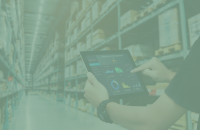Brick-and-Mortar Is Here to Stay. 3 Reasons Why You Should Adopt a Hybrid Retail Strategy in 2023
Online retail is growing remarkably. Global e-commerce sales accounted for 19% of retail sales in 2019. This number is expected to rise to 25% by 2026. But does this mean brick-and-mortar stores are on the path of embracing obsolescence?
Not exactly.
The general prediction for the future of brick-and-mortar was a doomsday scenario for retail stores during and post-pandemic. In contrast, reality has been starkly different. In 2021, store openings doubled the number of store closures. Moving forward, Forrester Research estimates that 72% of retail sales will occur at physical stores by this year. Numbers like these indicate that the offline shopping experience is still valuable for shoppers.
Let’s take a look at the current outlook for online and offline retail and go over some actionable ways you can bridge the gap between the two for success.
What’s the current outlook of online and physical retail spaces?
According to Matthew Shay, President and CEO of the National Retail Federation, there are four million retail establishments in the US, and one out of four US jobs belong to retail. Moreover, their sales have grown by 31%, validating their potential.
While the pandemic did lead to a surge in e-commerce, it doesn’t mean the end for offline retail. It’s essential to realize that forced behaviours are temporary. Having to do all the shopping online and shift to online-only interactions, as during the pandemic, isn’t going to last forever. People are already desiring to go back to in-store shopping. Moreover, people are now also indulging in non-essential luxury purchases, which makes in-store experiences even more valuable.
What must be noted is that all customers desire a convenient and enjoyable shopping experience today. This experience can be online, offline, or both, and buyers aren’t choosing one over another. Therefore, Marvin Ellison, the Chairman and CEO of Lowe’s has suggested that retailers focus on simplifying shopping and making it accessible across different platforms.
A hybrid retail strategy offers more advantages
As a retailer planning your next move, you must realize that online and brick-and-mortar stores needn’t be mutually exclusive. Instead, it would help if you weaved them together to create an omnichannel shopping experience with facilities like:
- Enabling customers to browse what they want online and picking it up at a store nearby.
- Checking out products physically and ordering online at their convenience.
- A hybrid online-offline shopping experience right at the store.
The Way Ahead – How to complement e-commerce with a physical shopping experience
Here are some actionable ways:
- Implement an omnichannel retail strategy
If you want to adopt a hybrid strategy to ensure that your products are available online as quickly as in physical stores, you need to:
- Automate inventory management, order fulfillment, and customer service to remove manual intervention and friction.
- Ensure payments go through smoothly on your website, mobile application, and physical stores.
- Track key performance indicators (KPIs) concerning online and offline sales to make necessary improvements.
A full-fledged point-of-sales (PoS) system can help you do this efficiently and effectively.
- Make online shopping accessible
Currently, the average cart abandonment rate on desktops is 70%, and on mobiles and tablets, 86% and 81%, respectively. However, with a hybrid approach, you can improve this metric. Some ways include:
- Fixing and updating your website and app to ensure a seamless UI-UX.
- Ensuring your orders and payments go through smoothly
- Being available on support and social media to answer queries and provide information promptly
- Enabling customers to create accounts to add their most viewed or liked products to shopping lists
- Making your retail store mobile-friendly by accepting mobile payments, allowing customers to scan barcodes on a dedicated app, or taking pictures of products at your store
The options are endless.
- Design physical stores to be tech-enabled
You can also implement automation and conventional technology together to enhance the shopping experience at physical stores. This is possible by:
- Placing touchscreen displays and connected interfaces strategically. With this, customers can browse products and online shopping lists digitally at your physical stores
- Equipping all your stores with cloud-based PoS solutions so customer data is synced in real-time online and offline
- Training your staff on using PoS before implementation so there are no hiccups when it goes live
Bottom line: Embrace the union of digital and physical retail
With digitization deepening its roots, it’s time to ramp up retail to create the ultimate shopping experience, irrespective of location. Customers today want convenience and ease, and that lies in hybrid.
If you’re a retailer, you must build a sound infrastructure to facilitate that excellent hybrid experience. For this, you need motivated staff to help in-store shoppers and provide prompt online customer support, along with a seamless browsing experience – both online and offline. At that same time, you also need to ensure smooth payments, irrespective of buying location.
Retail solutions from Magstar can help you improve your administrative efficiency and free up your staff’s time to focus on building customer relationships. Magstar POS’s mobile features are staff and customer friendly. Using it, staff can easily engage in inventory verification using mobile and respond to customer inquiries instantly. The POS solution also ensures smooth, agile transactions produce detailed sales and customer profile data. It’s a great way to ramp up the retail shopping experience for your customers and grow. Contact us today to learn more about how Magstar can help implement an omnichannel shopping experience.
RECENT POSTS
 How to Effectively Transition to Multichannel RetailingIf you’re worried that your midsized brick-and-mortar chain might [...]
How to Effectively Transition to Multichannel RetailingIf you’re worried that your midsized brick-and-mortar chain might [...] Follow these 7 Tips for Increasing Warehouse Efficiency Using ERP SoftwareOnline retail is growing remarkably. Global e-commerce sales accounted [...]
Follow these 7 Tips for Increasing Warehouse Efficiency Using ERP SoftwareOnline retail is growing remarkably. Global e-commerce sales accounted [...] How to Create an Effective Fulfillment Warehouse for Your Online OrdersOnline retail is growing remarkably. Global e-commerce sales accounted [...]
How to Create an Effective Fulfillment Warehouse for Your Online OrdersOnline retail is growing remarkably. Global e-commerce sales accounted [...]